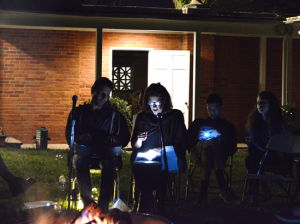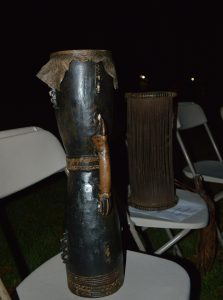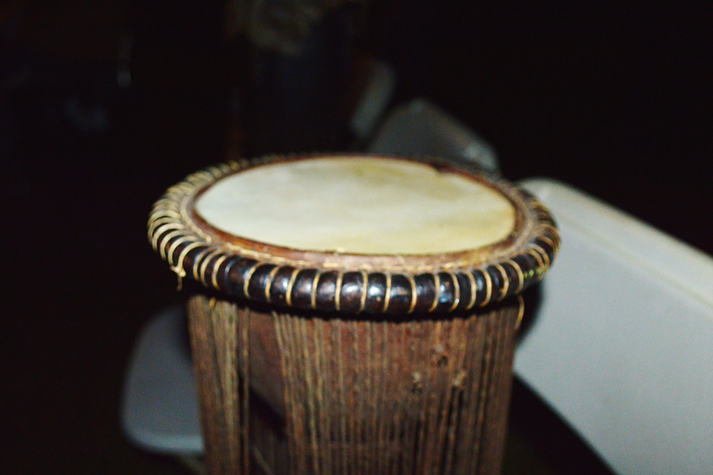Selichot Drum Circle centers Jewish community for Days of Awe
Adonia, Adonai, El Rahum v’Chanun Erech Apayim v’rav chesed v’emet.
Notzer chesed l’alafim noseh avon v’fesha v’chatah v’nakeh.
G-d, G-d is gracious and compassionate, patient,
abounding in kindness and faithfulness,
assuring love for a thousand generations,
forgiving iniquity, transgression and sin,
and granting pardon.
In the Jewish tradition, the period prior to Yom Kippur is a time for soul-searching, reflection and penance. Part of that penance is a solemn beating of the breast while sorrowfully reciting the prayer Ashamnu – “We are guilty.”
For those familiar with the stark, confessional prayer, it may seem like a stretch to replace the pounding fist with the steady beat of a drum. But for an earnest group of members and guests of Beth El Congregation in Baltimore, the transition truly strikes a thought-provoking chord.
Witness the Selichot services I attended at Beth El last Saturday night.
“Selichot (are) communal prayers for Divine forgiveness, said during the High Holiday season or on Jewish fast days. While most Jewish services are held during the day or early evening, High Holiday Selichot are the exception, held in the wee hours of the morning. Drawing from a plethora of biblical verses and rabbinic teachings, they are a soul-stirring introduction to the Days of Awe.” (Chabad.org.)

Beth El featured two Selichot services to usher in the High Holiday season. The first, a more traditional service, was held in the Gorn Chapel of the Beth El complex on Park Heights Avenue. There, Cantor Thom King was joined by Rabbi Steven Schwartz, Rabbi Dana Saroken, cellist Evan Drachman and the men of the Beth El Choir, in a truly musical and meditative service created by Cantor King. A philosophical discussion concluded a post-service viewing of the 1959 television play, Bontche Schweig.
The 9 PM chapel service at Beth El was followed (for those who motored about a mile southeast of the synagogue) by an innovative midnight Selichot Drum Circle.
Facilitated by Rabbi Saroken and Jordan Goodman of Beatwell, the drum circle placed participants onto folding chairs, around a crackling fire pit, in the back yard of a private home on Old Court Road.
A number of the attendees brought their own instruments. For the rest, drums and other percussion implements were provided.
Prior to the drum service, Goodman – a rock musician who holds a Masters in Clinical Psychology – told me he believes the use of drums, in centering the mind, is universal.
“I’m a licensed psychotherapist, and I use drumming for group therapy. I’ll get referrals from doctors and psychologists, because of my musical background. I do corporate team building, stress reduction, mindfulness meditation. I’ll teach kids how to facilitate other people, so it’s like leadership development and social skills.
What happens when people beat on the drums?
“It’s all the context that I set.
“This morning, with the childern, we talked about emotional regulation. So they’re thinking about when they’re angry, or when they’re sad. Behaviors that happen, like whether they punch something out of frustration versus playing a drum. Getting some of that aggressiveness out in a productive way, and feeling supported and connected with the group. It’s metaphors, but it’s also the work is the work.”
Goodman said this is the second year he is facilitating a Selichot Drum circle. “The service is a collaborative effort with Rabbi Saroken.
“We took some of the text and figured out what would resonate most with an audience. Then I figured out how I could take the content and make it come to life with the drumming.”

Last year’s service drew about sixty people. This year, I counted some twenty more.
“Last year marked the first time anybody in this community has done anything like this. It was at a stranger’s house at midnight; 60 people came. And now, there’s more coming this year. Ninety percent of the people I share my work with are doing something like this for the first time. I think they’re surprised by how easy it is; how natural it is for them to be musical; how quick it can be to feel more profoundly connected. People just feel good. And it’s simple.”
When asked what the service means to him, Goodman admitted that is he not religious. But later, Saroken gently goaded him into stating his observation, that, “For me, this is an exercise in owning our s**t.”
The drum service began with an admonition from Saroken to consider that now is the season for turning.
“Turn us around, G-d, and bring us back towards You. Restore our lives, as at the beginning. And turn us toward each other, G-d, for in isolation there is no life.”
“I want you to think for a minute,” said Saroken, “if you had a magic wand, and could fix or improve something, what would it be? It could be something in the world we’re living in right now, or it could something in our own small piece of the world. What do you think you’d focus on? What feels urgent? What feels broken? What needs to change for us to live our lives in a better world?”
Admittedly, the initial round of drumming felt somewhat forced, as people tried to connect the odd tribal rhythm with the rabbi’s text. But when we turned to the Ashamnu and started to confess the litany of sins, there was the sense the drumbeats were carrying our prayers to Heaven.
Ashamnu – we are guilty
Hamasnu – we are cruel
Sararnu – we are ruthless
Tzararnu – we oppress
The drumming this time began, not on Goodman’s cue, but as the spirit moved those in the circle. The difference was palpable, as the group seemed to come together as a community – entreating the Divine for mercy and direction.
If there was any question about using drums to center the penitent group for Selichot, the comments we shared throughout the service surely laid those questions to rest.

“I’d like to see an end of anti-Semitism,” said one participant, in answer to Saroken’s question about world-wide change.
“It would be nice,” noted a woman, “If we could come together as a nation.”
“With the drumming, I’m getting that we are vibrational beings,” offered a voice from the back.
“Tolerance,” averred one man. “When we started, I heard dissonant sounds, and I found that disturbing. But as I listened, I let it sorta harmonize in my head, and I thought that, with other people, we should be more tolerant.”
“I got a real sense of connection,” concluded another woman. “We’ve lost touch with one-another by relying on text messages and social media. When I touched the drum, I felt a connection. Someone was shaking a tambourine, and as she was doing that, I felt like my hand was with hers. It was a very strong feeling of connection.”
The smoking embers of the fire signaled the service was about to end.
“The reason I am here again to facilitate this circle is that I do trust the group,” said Jordan. “I trust that you will come together as a community; to work together and ultimately connect. With the drumming we created vibrations and connected vibrationally. That’s what, fifty years from now, I will remember about this night.”
Saroken added, “I hope that what we take from here tonight is an awakening from our slumber. That we will all hear the cries of a world that feels pretty broken.”
* * * * *
Editor’s note: This is the sixteenth part of an ongoing series which will look at the places and people that make up the rich history and diverse nature of spirituality, belief, and observance in Baltimore and beyond. Read the series here.

Anthony C. Hayes is an actor, author, raconteur, rapscallion and bon vivant. A one-time newsboy for the Evening Sun and professional presence at the Washington Herald, Tony’s poetry, photography, humor, and prose have also been featured in Smile, Hon, You’re in Baltimore!, Destination Maryland, Magic Octopus Magazine, Los Angeles Post-Examiner, Voice of Baltimore, SmartCEO, Alvarez Fiction, and Tales of Blood and Roses. If you notice that his work has been purloined, please let him know. As the Good Book says, “Thou shalt not steal.”

